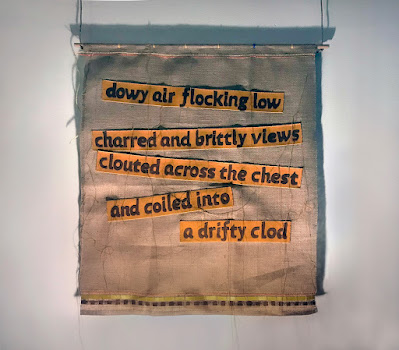WAKE EVERY MORNING CAN’T BLOODY MOVE
Wake in the darkness of me
Wake with the sun in my mouth.
(A BOOK OF OURS Calendar, from October)
January, Calendar. A BOOK OF OURS
Herewith three golden sets <
is “an ancient manuscript for our time” scribed by over 150 people affected by homelessness. In it, they depict their lives through poetry, artworks, calligraphy, songs and chants -- a visual poetic epic telling of contemporary British homelessness, using the form of medieval manuscripts, especially the Book of Hours. By echoing an ancient medieval heritage, it gives a place for contemporary homeless heritage, a kind of Trojan Horse to enter the citadel. This collaborative project was co-directed by artist Lois Blackburn and poet Philip Davenport, as arthur+martha in Manchester UK 2018-21, supported by the Heritage Fund. A detailed 10,000 word Commentary was written about these pages by Jeffrey Robinson: the spine for this virtual iteration of A BOOK OF OURS.
karl kempton published kaldron on paper from 1976-1990 (in 1997 it moved online). It is/was (according to its masthead): “North America’s Longest Running Visual Poetry Magazine”. As such it is significant archive of experimentation with fusions of word and image, mail-art, concrete and other sundry items of literary marginalia. kempton refers to the divide between the Orphic and Concrete movements, between the rune (meditation) and poem (mental states). “The polarity remains with us today between the head and heart, the materialist and the mystic” (p.4). The Orphic movement was founded by Apollinaire, it’s focus was on raw transcendence, passion, the pure instant; in kempton’s words, it was "dedicated to a purity of abstraction." The Concrete movement focalized around formalized theorems and structural ideas of what constituted a real concrete poem; their concerns were in protecting a didactic lineage. kempton identifies a lineage of Orphic poets (who were also visual poets) exiled from the canon of Concrete poetry anthologies: among them indigenous artists (petroglyphs…), Kenneth Patchen and Paul Reps.
THREE x 3 =
In homage to the recent anthology of women's visual poetry, Judith
Liz Collini & Lindsay Simons. Language art sequence.
The ancient sibyls as a source from which to spark new ideas /female figures representing power and agency; writing, speaking; the leaves as carriers of prophesies; our own place as women entering our ‘third’ age / (via Marina Warner’s From the Beast to the Blonde) / Book VI of Virgil’s Aeneid offered another set of prompts; Aeneas meets the Cumaean Sibyl and is taken to the underworld, eventually reaching the Elysian Fields and meeting his dead father / how many versions, how many translations?; the hundred caves, openings, voices through which the Sibyl speaks, as described by Virgil; oval/ova/mouth/orifice; female orifices the sibyl in the bottle, the sibyl in the bottle in the cave
Guest Editor Judy Kleinberg
Visual poetry is not static; its forms and definition evolve. It embraces history, craft, and technology. It refers, in varying degrees, to traditional forms such as painting, collage, sculpture, literature, music, and textiles. At the same time, it calls upon the future to look and look again, to release preconceptions, encouraging the evolution of the form.
Guest editor Rachel Robinson
What, then, is the role of the author? Does the author control what happens, or does s/he facilitate something that happens on its own? Is s/he like Rimbaud’s concert master who waves his bow and the symphony comes onto the stage of its own accord? The poet is the one who uses Flash to tell the computer to command both the letters and the gibberish sounds to act...
What, then, is the role of the author? Does the author control what happens, or does s/he facilitate something that happens on its own? Is s/he like Rimbaud’s concert master who waves his bow and the symphony comes onto the stage of its own accord? The poet is the one who uses Flash to tell the computer to command both the letters and the gibberish sounds to act...
PS = Bi-erasure & others. Astra Papachristodoulou
THIS ISSUE OF SYNAPSE WAS CONCEIVED & COMPILED BY PHIL DAVENPORT, IN CONSULTATION WITH KARL KEMPTON
ABOVE:
January, Calendar, various artists. A BOOK OF OURS.
Photograph by Lois Blackburn
BELOW:
Banner for Maggie O'Sullivan, by Astra Papachristodoulou
THIS ISSUE OF SYNAPSE WAS CONCEIVED & COMPILED BY PHIL DAVENPORT, IN CONSULTATION WITH KARL KEMPTON
ABOVE:
January, Calendar, various artists. A BOOK OF OURS.
Photograph by Lois Blackburn
BELOW:
Banner for Maggie O'Sullivan, by Astra Papachristodoulou
"rituals and rules, the docile to consume not product but space,
docile bodies moving
quickly is an unfamiliar image of the internal bleeding/breeding of empire."
From: The Geometric Perspective Augmented with Cycles Normalization. Tony Trehy


Comments
Post a Comment